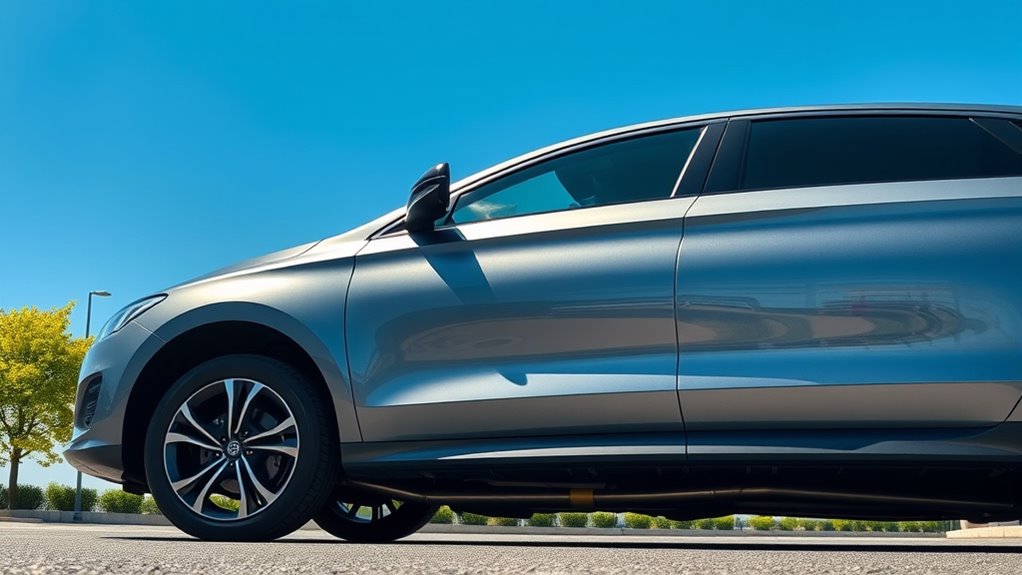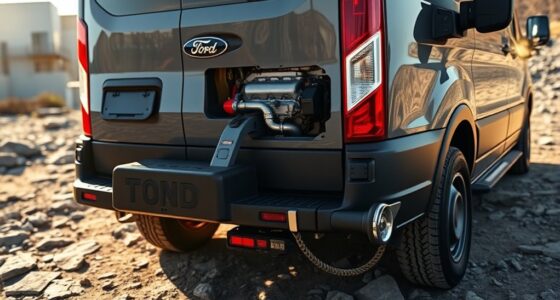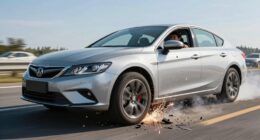Emission standards like Euro 6 and EPA regulations set strict limits on pollutants from vehicles to protect air quality and health. Euro 6, used in Europe, reduces NOx emissions from diesel cars markedly, while the EPA enforces evolving standards across the U.S. to control smog, acid rain, and climate impacts. Automakers invest heavily to meet these rules using advanced technologies. Keep exploring to discover how these standards are shaping cleaner, greener vehicles for the future.
Key Takeaways
- Euro 6 limits NOx emissions from diesel cars to 80 mg/km, reducing smog-forming pollutants in Europe.
- EPA standards enforce increasingly strict vehicle emission limits to combat air pollution and protect public health in the U.S.
- Both regulations require advanced technologies like catalytic converters, particulate filters, and engine calibration improvements.
- Compliance with these standards involves continuous technological innovation by automakers to meet evolving limits.
- The standards aim to promote cleaner vehicle technologies, improve air quality, and support environmentally sustainable transportation.

Have you ever wondered how governments limit pollution from vehicles and industries? It all comes down to emissions standards—regulations designed to control the amount of harmful pollutants released into the atmosphere. These standards set specific limits on emissions like nitrogen oxides (NOx), particulate matter (PM), carbon monoxide (CO), and unburned hydrocarbons. Different regions have their own systems, but two of the most influential are the European Union’s Euro standards and the United States’ Environmental Protection Agency (EPA) regulations. Both aim to improve air quality, protect public health, and encourage automakers to develop cleaner technologies.
Euro 6, the latest in the European series, tightened emission limits markedly compared to previous versions. If you drive a vehicle sold in Europe, it’s likely designed to meet Euro 6 standards. These regulations restrict NOx emissions from diesel cars to just 80 milligrams per kilometer, a substantial reduction from earlier standards. The goal is to curb smog-forming pollutants that cause respiratory problems and environmental damage.
Euro 6 limits NOx emissions from diesel cars to 80 mg/km, reducing pollution and protecting health.
To meet Euro 6, automakers incorporate advanced technologies like selective catalytic reduction (SCR), particulate filters, and improved fuel injection systems. These innovations help engines burn cleaner and reduce harmful emissions, making European vehicles among the cleanest in the world.
Across the Atlantic, the EPA enforces detailed standards that regulate vehicle emissions in the U.S. market. EPA compliance involves multiple phases, each targeting more rigorous limits as technology advances. When you buy or operate a vehicle in the U.S., it must meet these standards to be legally sold and driven.
The EPA’s rules focus on controlling pollutants that contribute to smog, acid rain, and climate change. To adhere, automakers deploy technologies similar to those used in Europe—catalytic converters, advanced exhaust aftertreatment systems, and engine calibration improvements. These measures ensure vehicles emit fewer pollutants, helping to meet the national air quality goals.
Both Euro 6 and EPA standards aren’t static; they evolve as technology improves and environmental priorities shift. Automakers invest heavily in research and development to stay compliant while also offering consumers cleaner, more efficient vehicles.
Understanding these standards is crucial because compliance technology plays a vital role in reducing harmful emissions and shaping the future of eco-friendly transportation. As a driver or consumer, understanding these standards helps you appreciate the efforts behind the cars you see on the road—designed to be safer for both your health and the environment. In essence, emissions standards like Euro 6 and EPA regulations serve as crucial tools that push industries toward innovation, ensuring that economic progress doesn’t come at the expense of air quality.
Frequently Asked Questions
How Do Euro 6 and EPA Standards Differ Globally?
Euro 6 and EPA standards differ mainly in their limits and testing procedures. Euro 6, used in Europe, tends to be stricter on nitrogen oxides (NOx) emissions but more lenient on particulate matter (PM).
EPA standards, in the US, set specific limits for pollutants and require real-world testing, often making compliance more complex for manufacturers. These differences influence vehicle design and emissions control strategies worldwide.
What Are the Penalties for Non-Compliance?
If you don’t adhere to Euro 6 or EPA standards, you face hefty fines, legal actions, and potential vehicle recalls.
Manufacturers can also be barred from selling non-compliant vehicles, damaging your reputation and profits.
Additionally, non-compliance can lead to increased scrutiny from regulators, which may result in stricter future regulations.
Staying compliant helps you avoid these penalties and ensures your vehicles meet environmental and safety standards.
How Often Are Emissions Standards Updated?
Imagine your vehicle’s emissions standards change every few years. Typically, updates occur every 4-6 years, driven by technological advances and environmental goals.
For example, Euro 6 standards were updated in 2014 and revised in 2018. These updates aim to reduce pollutants and improve air quality.
Staying informed guarantees your vehicle remains compliant, helping you avoid penalties. Manufacturers and regulators work closely to implement these updates smoothly and timely.
Do Standards Vary for Different Vehicle Types?
Yes, emissions standards vary depending on vehicle types. For example, passenger cars, trucks, and buses each face different limits because they’ve distinct engine technologies and usage patterns.
You should check specific regulations for your vehicle category, as standards are tailored to guarantee environmental protection while accommodating the performance needs of each vehicle type.
Staying compliant means understanding these differences and adhering to the relevant standards applicable to your vehicle.
What Technological Innovations Help Meet These Standards?
Did you know that hybrid and electric vehicles typically emit 50-70% fewer pollutants?
To meet these standards, you use advanced technologies like catalytic converters, which reduce harmful gases, and direct injection systems that optimize fuel combustion.
Additionally, you benefit from onboard diagnostics that monitor emissions in real-time.
These innovations help your vehicle stay compliant, improve fuel efficiency, and reduce environmental impact effectively.
Conclusion
Staying compliant with Euro 6 and EPA standards might seem challenging, but it’s essential for protecting our planet and ensuring your vehicle’s future. Think of these standards as the ultimate gatekeepers, preventing pollution from reaching catastrophic levels. By understanding and adhering to them, you’re not just driving responsibly—you’re helping to prevent environmental chaos on a scale more staggering than you can imagine. So, embrace these regulations; they’re your best defense against a polluted, unsustainable world.









